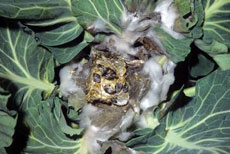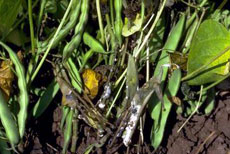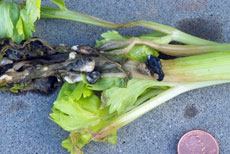Join us at the 2014 Integrated Pest Management Academy to discuss strategies to help manage vegetable disease on diverse vegetable farms.
Plant disease management is essential on the vegetable farm to achieve optimal yield and profit. When a susceptible host, a pathogen and favorable environmental conditions are present, disease and its associated symptoms develop. Plant pathogens infect plants and impact its ability to continue growing, potentially affecting the quality and yield of the crop plant.
A comprehensive disease management approach is needed in order to minimize and limit the negative impact that diseases can have on vegetable crops. Disease control options vary in strategy, timing, duration and efficacy, but when control options are combined in a holistic and integrated approach, the risk of disease-driven losses is minimized.
Achieving adequate disease management requires a detailed crop rotation plan that brings to the table multiple crops and crop families. This strategy has many advantages from a disease management standpoint. For soil borne pathogens, the number of pathogen propagules (seeds of the pathogen) tend to decrease if its prime host is not planted in the same field consecutively and adequate time is allowed between rotations of the same crop. The duration of time between crop rotation is host and pathogen dependent.
Based on this concept of limiting host availability over time, a common practice for Michigan farmers is to plan their season staggering crops from different families (cole crops, legumes, etc.) in their fields. Typically, cool season vegetables are planted first and then replaced with cold-sensitive vegetables as temperatures permit.
This process is complicated in some vegetable production rotations due to the large host range of several pathogens. In some cases, pathogens have the ability to infect several members of the same plant family, for example solanaceous plants including tomatoes and peppers are prone to many of the same pathogens.
Additionally, some pathogens have the ability to cause disease in a broad number of plants and plant families. For example, white mold, also known as Sclerotinia rot, a fungal disease caused by Sclerotiniasclerotiorum, is a common problem in crops that belong to the legume family, including beans, but this fungus can also infect crops in onion, pepper and cabbage families (Alliaceae, Solanaceae and Brasicaceae, respectively).In fact, Sclerotiniasclerotiorum also infects and causes disease on celery, but the disease is called Sclerotinia pink rot.
When disease is advanced, the structures of the pathogen can be readily observed (Photos 1-3).This is just one example of many non-selective pathogens that can complicate the management strategies of vegetable producers.



Photos 1-3. (Top) Sclerotinia stem rot and watery soft rot, also known as white mold, in kale. (Middle) White mold in bean. (Bottom) Sclerotinia pink rot or pink rot in celery.





